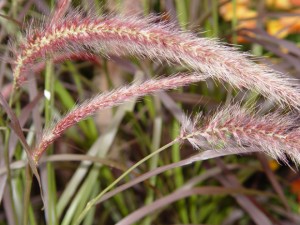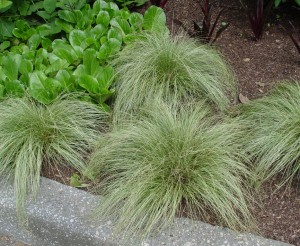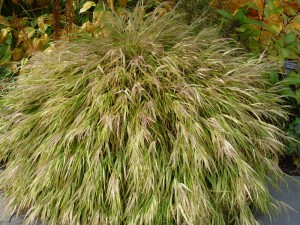Sedges and Grasses
Posted in Gardening Tips on November 22 2011, by Sonia Uyterhoeven
 A few weeks ago, I was displaying some grasses and sedges for a home gardening demonstration when a woman asked me what the difference is between the two. Naturally, there are anatomical and sometimes cultural differences (always generalizations) between these similar plants, however, they are often categorized together and thought of as the same. To help clarify the differences, we will begin with a useful mnemonic:
A few weeks ago, I was displaying some grasses and sedges for a home gardening demonstration when a woman asked me what the difference is between the two. Naturally, there are anatomical and sometimes cultural differences (always generalizations) between these similar plants, however, they are often categorized together and thought of as the same. To help clarify the differences, we will begin with a useful mnemonic:
Sedges have edges,
Rushes are round,
Grasses have nodes from the top to the ground.
Grasses and bamboos are in the Graminaceae family, sedges are in the Cyperaceae family, and rushes are in the Juncaceae family. When you look at a grass or sedge, what you see are the stems, leaves, and flowers. And in the case of this explanation, the stems are referred to as culms.
Explaining that earlier bit of verse requires some plant anatomy, however. In grasses, the culms are cylindrical and covered in nodes (swollen joints); if you were to cut open a grass or bamboo, you would notice that the culms are hollow, and the nodes are solid. But with sedges–which have no nodes–it is the culms themselves that are solid (not to mention triangular). And finally, rushes are round like grasses, but are similar to sedges in that they have solid culms and an absence of nodes. This can all be somewhat difficult to remember, but the mnemonic above should make more sense to you now.
Out of the three families, the ornamental grasses have the showiest flowers. The inflorescence–or flowering part–is sometimes shaped as a collection of showy plumes, bottlebrush spikes, oat-like seed heads or silky, hair-like structures called awns.
If you visit the Home Gardening Center any time from August into November, you will undoubtedly find the warm season ornamental grasses stealing the show with their billowy blooms. One that takes almost everyone by surprise is the pink muhly grass (Muhlenbergia capillaris), with airy panicles that create a rich, pink haze. We also grow an annual fountain grass (Pennisetum setaceum ‘Burgundy Giant’) that has a deep burgundy color and large racemes (an inflorescence where the flowers are attached to the stem by short stalks) that look like fuzzy bottle brushes.

Many of the fountain grasses’ flowering structures make wonderful additions to late season flower arrangements. However, we have taken most of the hardy fountain grasses out of the garden because of their habit of seeding around in places they’re not welcome, and instead content ourselves with a wide selection of annual fountain grasses.
For those looking to add to their gardens, the majority of ornamental grasses thrive in full sun and can handle drought magnificently. During the dry summers they are very little work, and taller varieties don’t often require staking. Wet summers are a different story, though, where staking is a requisite.
Because of their beautiful flowering structures, ornamental grasses are by far the most popular for gardeners, though sedges hold a special place in the hearts of those who prefer shade gardening. Most sedges tolerate shade better than grasses and–depending on the species–they handle a wide range of soils from wet to dry. Carex pensylvanica, sometimes referred to as Pennsylvania or oak sedge, is an ideal lawn substitute or ground cover for a shady spot. It has a fine texture and a graceful fountain habit that spills over the ground.
And if you are looking for something with broader leaves, Carex ‘Ice Dance’ has wonderfully variegated foliage. In our case, we had a bare, shady slope on the edge of the garden that was a breeding ground for weeds and washouts after every rainstorm. Two years ago we decided to cover the bank with small plugs of Carex, and it has since begun filling in nicely to provide a remedy to our problems.
Another feature that I appreciate about ‘Ice Dance’ is its flexibility. If I am running behind schedule in the spring and I forget to cut back its winter growth, it doesn’t seem to mind; the new growth covers the old and within a month it is looking just as perky as it was in the previous season.

Try to keep in mind that while sedges generally handle shade better than grasses, there are always exceptions to these generalizations; there is a whole host of sedges that thrive in full sun. And if you’re looking for something ideal in the grass family, one of the most versatile options for the shade garden is the Japanese forest grass (Hakonechloa macra).
When choosing a grass or sedge, educate yourself on its size and shape before you incorporate it into your garden. Decide whether you are growing it just for the foliage or for the flower, as well. Small sedges and grasses make wonderful edging for a border, while larger grasses are fantastic focal points that make strong statements. Grasses and sedges can also make nice backdrops for other plants. They are ideal for naturalistic, wildlife-friendly, low-maintenance, or sophisticated designs, and are also suitable for container plantings.
If you have been involved in growing them or are simply interested, what are your favorite grasses or sedges?


Why push Japanese grasses? Natives like Prairie dropseed, etc do a better job log lived and we don’t need any more introduced species.